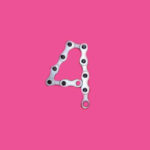Each month instead of trying for a baby during her natural cycle, a woman can have an IVF cycle instead. There are five steps in an IVF cycle:
Once you have decided to have an IVF cycle, the first step is getting your body ready. We advise all women to start taking folic acid (minimum dose 0.4mg/day) or to take a multivitamin supplement that contains folic acid. Sometimes a medication such as the birth control pill or a monthly injection will be given to you to prepare your ovaries and womb for your treatment. The results of all your screening blood tests need to be available at this point.
A human egg is microscopic and cannot be seen with the human eye. Just to give you an idea how small and delicate they are, up to 50 eggs could balance on the tip of a pin. They require carefully controlled environmental conditions such as warm temperatures and the right gases and nutrients.
In a woman’s natural cycle one egg grows a month. To give you a better chance of getting pregnant more eggs than this will help. To help your ovaries produce more than one egg a fertility drug (called FSH hormone) is taken by injection every day for between 8-14 days. This is carefully monitored by ultrasound scans and blood tests every few days.
Often a second drug (called Cetrotide) is needed for the last few days to prevent any eggs from being released and lost inside the woman’s body. After 8-14 days your eggs will be nicely grown and ready to be collected. At this point a special injection is given to mature your eggs so that they can be collected 34 – 36 hours later.
Eggs are collected by passing a needle through the wall of the vagina into the ovary guided by an ultrasound scan. It does not require surgery and is a minor procedure which takes around 30 minutes. The eggs will be collected into the needle one by one, and placed in an incubator in the fertility laboratory by the embryologist.
For the egg collection our anaesthetic doctor will give you pain killing drugs so that you are comfortable. Most women sleep through the procedure or say that they feel very little. We will need you to stay in the hospital for 3-4 hours after your egg collection until you are well enough to go home. Because of the drugs that you will have been given, you will not be able to work for the day and should not drive afterwards or sign any legal documents.
The day that the eggs are collected, the male partner needs to produce a sperm sample. If a donor sperm sample is being used this will be thawed. The sperm will be washed and carefully prepared so that the healthiest sperm are placed around the egg. The eggs and sperm are then placed in an incubator and left overnight to allow the natural process of the best sperm getting into the egg and fertilising it. If the sperm are low in numbers then they will have a low chance of getting into the egg on their own and ICSI or sperm injection will be a better option to give the best chance of fertilisation.
What is ICSI? ICSI (pronounced ick-see) or Intra-Cytoplasmic Sperm Injection involves injecting a single sperm into the centre of an egg. ICSI was one of the biggest advances in fertility treatment after IVF itself and has been in routine practice around the world for over twenty years. After the egg collection procedure, the eggs are prepared and examined by the embryologist in the IVF lab to check they are healthy and mature and will be suitable for sperm injection. Often 20-30% of a woman’s eggs are not healthy or mature.
In the IVF laboratory single sperm with the best shape (morphology) and swimming-ability (motility) is chosen by careful analysis of all the sperm under a microscope. The chosen sperm is gently sucked up inside a very thin glass needle. This needle is thinner than a human hair. The embryologist performs the ICSI injection using a special microscope. The pipette is positioned at the correct place ready for injection into the egg. The egg is held steady in a robotic holding pipette. The pipette pierces the outside of the egg and the inner membrane. Once the embryologist can see that the pipette is inside the egg, the sperm is injected gently into the centre of the egg and the pipette is carefully withdrawn.
The injected eggs are placed in an incubator and checked the next morning to see if they have fertilised. Usually 60-70% of injected eggs will fertilise although there is a small chance that none will fertilise (3.4%). Fertilised eggs (embryos) are then grown for a few more days in the IVF lab and watched carefully to see how they are developing. The best one two or three embryos are then chosen to be transferred back into the womb in the hope that a pregnancy will occur. Any remaining good quality embryos can be frozen and stored for future use.
REPLACING THE EMBRYOS INSIDE THE WOMB
Two to six days after the eggs have fertilised, the healthiest embryo or embryos are selected to be put back into the woman’s womb. This embryo transfer procedure is not painful and takes 10-15 minutes. It feels very like having a cervical PAP smear done.
The number of embryos to be placed inside the womb will be carefully decided by you along with your doctor and the embryologist. If suitable, remaining embryos can be frozen in case you have further IVF treatment. After the embryo transfer it will be 9-12 days before you can find out whether your IVF cycle was a successful one by having a pregnancy test.
Just like human eggs, human embryos are very delicate and so small that they cannot be seen with the human eye. Many embryos would fit on the tip of a pin. They require carefully controlled environmental conditions such as warm temperatures and the right gases and nutrients. They start as one cell and will eventually grow into the billions of cells that make up a human being. Your embryos are placed back inside your womb anywhere between the two cell stage (day 2 of their life) or the blastocyst stage on day 5 or 6 where they are now several hundred cells.
What is an embryologist?
An embryologist is a scientist (and sometimes a doctor) who is an expert in the fertility laboratory. Embryologists ensure the eggs are given the right environment to thrive in the IVF lab, prepare the sperm and where needed select the best sperm and inject it into an egg (ICSI). After egg collection the eggs and sperm are mixed and left to fertilise overnight. When the sperm quality is suboptimal the sperm are injected into the egg by ICSI. The next day the embryologist checks to see how many eggs have fertilised. Those that have fertilised (now called embryos) are watched carefully for another 1-4 days as they develop.




